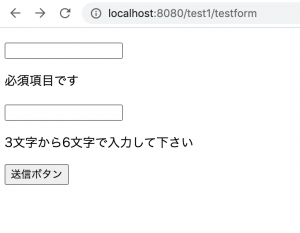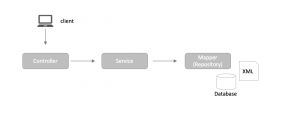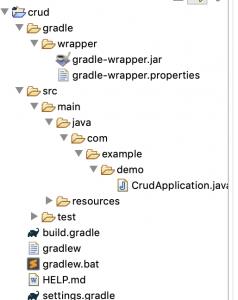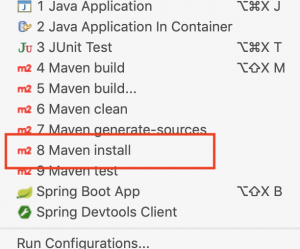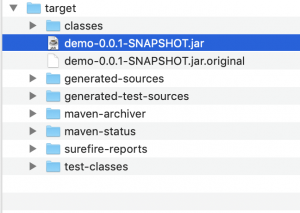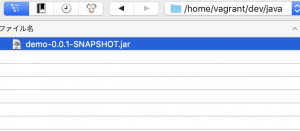まず、postgres側でテーブルを作ってデータを入れます。
create table weather (
id serial primary key,
location_id int,
name varchar(20),
temperature int,
humidity int,
date_time timestamp
);
test=> insert into weather (location_id, name, temperature, humidity, date_time) values
(1, ‘東京’, 15, 55, ‘2021-02-02 09:00:00’),
(1, ‘東京’, 16, 53, ‘2021-02-02 10:00:00’),
(1, ‘東京’, 17, 40, ‘2021-02-02 11:00:00’),
(2, ‘那覇’, 20, 65, ‘2021-02-02 09:00:00’),
(2, ‘那覇’, 22, 67, ‘2021-02-02 10:00:00’),
(2, ‘那覇’, 25, 69, ‘2021-02-02 11:00:00’);
INSERT 0 6
test=> select * from weather;
id | location_id | name | temperature | humidity | date_time
—-+————-+——+————-+———-+———————
1 | 1 | 東京 | 15 | 55 | 2021-02-02 09:00:00
2 | 1 | 東京 | 16 | 53 | 2021-02-02 10:00:00
3 | 1 | 東京 | 17 | 40 | 2021-02-02 11:00:00
4 | 2 | 那覇 | 20 | 65 | 2021-02-02 09:00:00
5 | 2 | 那覇 | 22 | 67 | 2021-02-02 10:00:00
6 | 2 | 那覇 | 25 | 69 | 2021-02-02 11:00:00
application.properties
server.port=8080
spring.jpa.database=POSTGRESQL
spring.datasource.url=jdbc:postgresql://localhost:5432/test
spring.datasource.username=postgres
spring.datasource.password=
pom.xml
<dependency>
<groupId>org.springframework.boot</groupId>
<artifactId>spring-boot-starter-data-jpa</artifactId>
</dependency>
<dependency>
<groupId>org.postgresql</groupId>
<artifactId>postgresql</artifactId>
<scope>runtime</scope>
</dependency>
model
Weather.java
package com.example.demo.model;
import java.sql.Timestamp;
import javax.persistence.Entity;
import javax.persistence.GeneratedValue;
import javax.persistence.GenerationType;
import javax.persistence.Id;
import javax.persistence.Table;
@Entity
@Table(name="weather")
public class Weather {
@Id
@GeneratedValue(strategy=GenerationType.IDENTITY)
private Integer id;
private Integer location_id;
private String name;
private Integer temperature;
private Integer humidity;
private Timestamp date_time;
public Integer getId() {
return id;
}
public void setId(Integer id) {
this.id = id;
}
public Integer getLocation_id() {
return location_id;
}
public void setLocation_id(Integer location_id) {
this.location_id = location_id;
}
public String getName() {
return name;
}
public void setName(String name) {
this.name = name;
}
public Integer getTemperature() {
return temperature;
}
public void setTemperature(Integer temperature) {
this.temperature = temperature;
}
public Integer getHumidity() {
return humidity;
}
public void setHumidity(Integer humidity) {
this.humidity = humidity;
}
public Timestamp getDate_time() {
return date_time;
}
public void setDate_time(Timestamp date_time) {
this.date_time = date_time;
}
}
repository/WeatherRepository.java
package com.example.demo.repository;
import org.springframework.data.jpa.repository.JpaRepository;
import org.springframework.stereotype.Repository;
import com.example.demo.model.Weather;
@Repository
public interface WeatherRepository extends JpaRepository<Weather, Integer>{}
service/WeatherService.java
package com.example.demo.service;
import java.util.List;
import org.springframework.beans.factory.annotation.Autowired;
import org.springframework.stereotype.Service;
import org.springframework.transaction.annotation.Transactional;
import com.example.demo.model.Weather;
import com.example.demo.repository.WeatherRepository;
@Service
@Transactional
public class WeatherService {
@Autowired
WeatherRepository weatherRepository;
public List<Weather> findAllWeatherData(){
return weatherRepository.findAll();
}
}
HelloController.java
package com.example.demo;
import java.util.List;
import org.springframework.beans.factory.annotation.Autowired;
import org.springframework.stereotype.Controller;
import org.springframework.ui.Model;
import org.springframework.web.bind.annotation.RequestMapping;
import com.example.demo.model.Weather;
import com.example.demo.service.WeatherService;
@Controller
public class HelloController {
@Autowired
WeatherService weatherService;
@RequestMapping("/hello")
public String hello(Model model) {
model.addAttribute("hello", "Hello World!");
List<Weather> weatherDataList = weatherService.findAllWeatherData();
model.addAttribute("weatherDataList", weatherDataList);
return "hello";
}
}
hello.html
<!Doctype html>
<html xmlns:th="http://www.thymeleaf.org">
<head>
<title>SpringBoot</title>
<meta http-equiv="Content-Type" content="text/html; charset=UTF-8"/>
<meta charset="UTF-8">
<!-- <link th:href="@{/css/common.css}" rel="stylesheet"></link>
<script th:src="@{/js/common.js}"></script> -->
</head>
<body>
<p>
<span th:text="${hello}">Hello World!</span>
</p>
<div>
<table>
<tr th:each="data: ${weatherDataList}" th:object="${data}">
<td th:text="*{id}"></td>
<td th:text="*{location_id}"></td>
<td th:text="*{name}"></td>
<td th:text="*{temperature}"></td>
<td th:text="*{humidity}"></td>
<td th:text="*{date_time}"></td>
</tr>
</table>
</div>
</body>
</html>
lsof -i:8080
Run As -> SpringBoot app
http://localhost:8080/hello

Hello World!
1 1 東京 15 55 2021-02-02 09:00:00.0
2 1 東京 16 53 2021-02-02 10:00:00.0
3 1 東京 17 40 2021-02-02 11:00:00.0
4 2 那覇 20 65 2021-02-02 09:00:00.0
5 2 那覇 22 67 2021-02-02 10:00:00.0
6 2 那覇 25 69 2021-02-02 11:00:00.0
うおおおおおおおおおおおおお
マジか。。。
これ、Javaでアプリ作れんじゃん。
